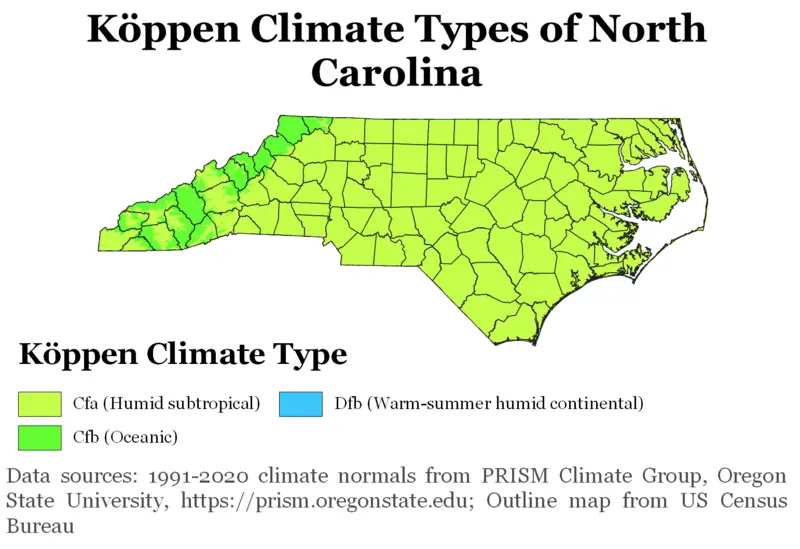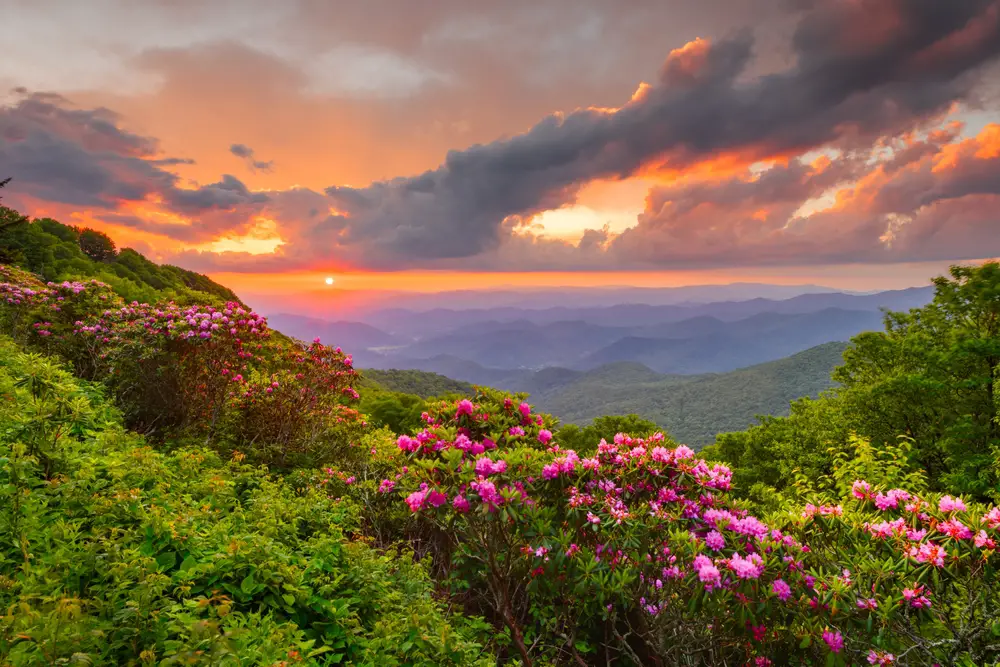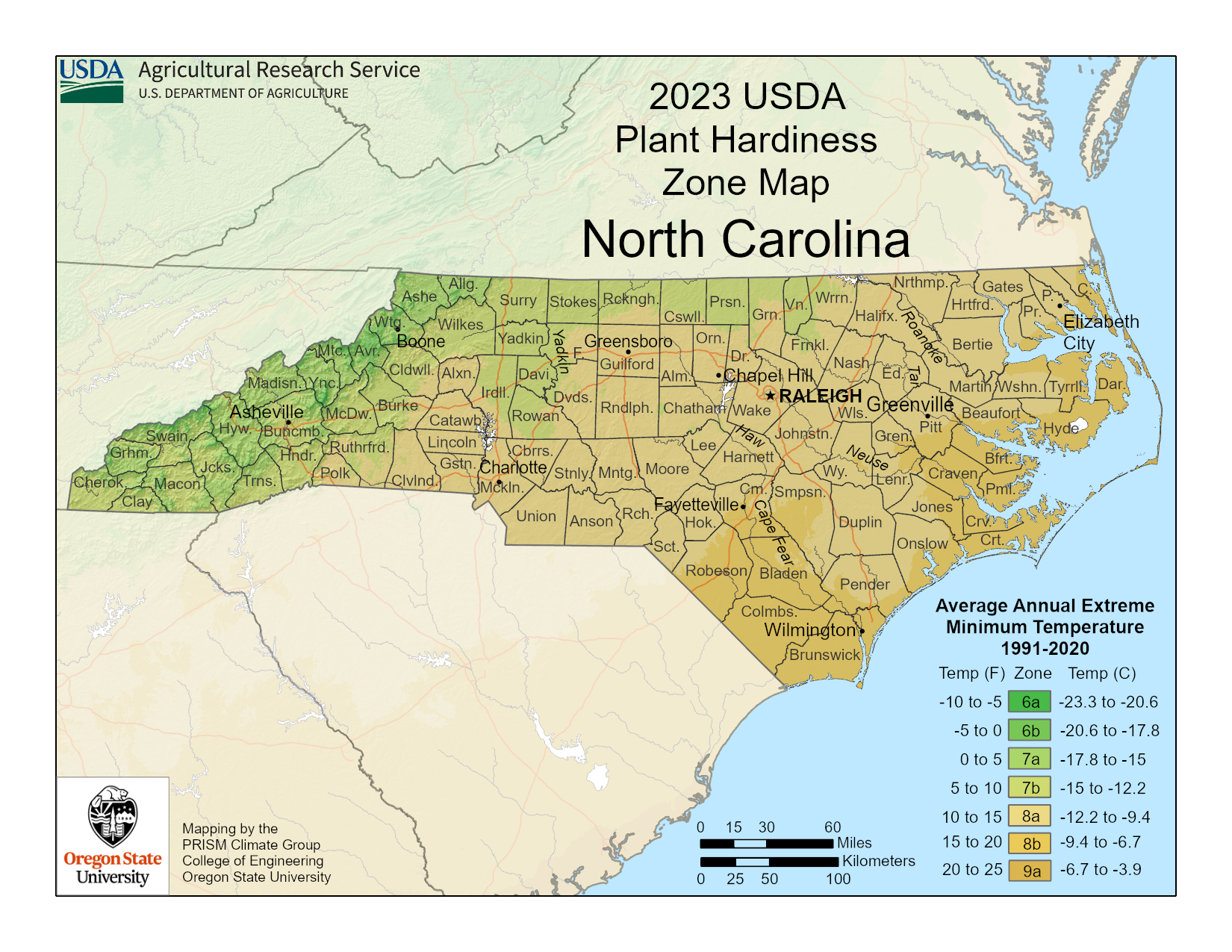North Carolina Plant Hardiness Zones
| USDA Hardiness Zone | Average Minimum Extreme Winter Temperature Range Fahrenheit (°F) Celsius (°C) | Average Last Frost Date Range In Spring (Beginning Of The Growing Season) | Average First Frost Date Range In Autumn (End Of The Growing Season) |
|---|---|---|---|
| 6a | -10°F to -5°F -23.3°C to 20.6°C | Late April to early May | Early to mid-October |
| 6b | -5°F to 0°F -20.6°C to 17.8°C | Late April to early May | Early to mid-October |
| 7a | 0°F to 5°F -17.8°C to -15°C | Late April to early May | Mid to late October |
| 7b | 5°F to 10°F -15°C to -12.2°C | Early April to mid-April | Late October to early November |
| 8a | 10°F to 15°F -12.2°C to -9.4°C | Late March to early April | Late October to Early November |
| 8b | 15°F to 20°F -9.4°C to -6.7°C | Late March to early April | Late October to Early November |
| 9a | 20°F to 25°F -6.7°C to -3.9°C | Late March to early April | Early to mid-November |
North Carolina Growing Conditions

General Climate
North Carolina plant hardiness zones range from 6a to 9a. Most of the state is defined as a humid subtropical climate. The westerly portion of the state has a subtropical highland climate due the higher elevations of the Appalachian Mountains.
To the east, the Atlantic coast creates a moderating effect on the weather. Here, the summers stay warm and the winters stay cool. This is due to the air currents moving inland from across the ocean. As the cool air flows over the warmer water it warms the air and moderates the conditions on land.
The Appalachian Mountains run along the western state line and act as a weather barrier. The mountain range stops the continental cold weather and storms coming in from the midwest. This creates a warmer climate overall.
July is the month with the most rain, totalling an average of 45 inches (114.3 centimeters) of rain annually.
Snow occurs in the Appalachian Mountains with an average of 5 inches (12.7 centimeters) a year. The coastline sees an average of 2 inches (5.08 centimeters).
Microclimates
USDA plant hardiness zones are an important starting point for your garden, but you’ll also need to consider microclimates.
Microclimates are areas where specific conditions create a climate different from the climate they’re situated in.
Buildings, fences, paved areas, or short hills and valleys can create these microclimates.
They can be as small as a space in your backyard or as large as a city.
In other words, learn about your local conditions from local experts to see if your garden falls into a microclimate.
Extreme Weather
High Heat & Humidity
Within the North Carolina plant hardiness zones, there are hot and humid summers. In areas of high humidity, powdery mildew can be a common garden issue. It is a fungal disease that appears white and powdery on the leaves.
Powdery mildew spreads easily and affects the plant’s health and production. This fungal disease most commonly affects:
- Squash
- Cucumbers
- Pumpkins
- Tomatoes
- Roses
Creating more airflow around the plants helps mitigate against powdery mildew. Do this by removing leaves from the plants so they aren’t overcrowded or touching. This method will also reduce humidity levels.
Powdery mildew is more likely to occur in the shade. Keeping plants in a sunny location helps to dry out any possible fungal growth.
You can use baking soda to kill powdery mildew. This remedy is garden safe and does not affect any insects or animals. Simply, dilute 1 teaspoon of baking soda into 4 cups (0.94 liters) of water and spray infected plants with solution.
Tornadoes
North Carolina’s most common extreme form of weather is severe thunderstorms and tornadoes.
While North Carolina can experience tornadoes in any month of the year, the tornado season usually runs from March until May. There are an average of 31 tornadoes per year.
Aside from general storm preparations, try planting trees and shrubs on your property with strong root systems.
Trees like willow or oak have deep taproots that can withstand winds to a certain extent. By removing dead and wayward branches annually, you are also preventing easy breakage that may occur during a storm.
Taking preventative measures is important, but it also comes down to sheer luck! Extreme tornados are very destructive.
Growing Season
The growing season for North Carolina plant hardiness zones begins in late March and runs to early October. There are an average of 175 frost-free days.
Areas closer to the Appalachian Mountains have a shorter growing season and experience more snow. Areas close to the Atlantic Ocean have the longest growing season with very little snow during the winter season.
Using a greenhouse or cold frame in the western portion of the state is a good way to extend the growing season.
By using a greenhouse or cold frame you can grow greens like spinach, lettuce, and parsley year round.
North Carolina Gardening Tips

Create Habitat For The Eastern Box Turtle
North Carolina is home to the eastern box turtle. They are a terrestrial turtle, spending all of their life on land.
Turtles have been on this planet for over 250 million years! They are considered long-lived organisms. This means that they have changed very little over the long period of time they have been around!
Box turtles are also an indicator species. This means that their population’s health mirrors the health of the environment. So if their population is in decline, it indicates that the environment is also suffering.
Due to habitat destruction, road mortality, and pesticide use their population is declining.
Box turtles are classified as a vulnerable species with the IUCN (International Union for Conservation of Nature). This means their population is declining but the species is not considered endangered yet.
These animals play an important role in the ecosystems through population control of garden pests like slugs. They are also pollinators of sorts! They aid in seed dispersal of native fruiting plants. They do this by eating the fruits and pooping out the seeds somewhere new!
What To Do For Eastern Box Turtles
Help Eastern box turtles by creating a garden that is beneficial for their growth and development. Here are some tips to create a healthy environment for this turtle.
- Food: native fruits are an important part of their diet. Include some in your garden. Choose varieties like:
- Raspberries
- Strawberries
- Blackberries
- Persimmon
- Habit: box turtles enjoy spending time in the shelter of leaf litter. This is how they cool down or hunt for prey like slugs and snails. They also use these areas to hibernate. Leave leaf litter in the fall to provide them with hunting grounds and overwintering habitat.
- Go Organic: pesticides can harm turtles and other beneficial insects. By keeping your garden organic, you are growing sustainably and helping more than just the box turtle.
Plant For Mason Bees
The mason bee is valuable for its aid in fruit tree production. They are prized in commercial orchards for their hard work. In one day, one individual bee can visit over 2,000 flowers and pollinate around 90% of them!
Choose trees that benefit from the mason bee such as:
- Cherry
- Pear
- Apple
- Blueberry
- Almond
It’s also important to plant a diversified landscape for the bees. This creates a reliable and continual food source throughout the seasons.
Don’t forget about nesting and overwintering materials as well. Mason bees will use pre-existing structures to hibernate in. Plants with hollow stems, like sedum or native aster, work well. But you can also add a mason bee home to your garden.
Mason Bee Home
Mason bee homes are a fun and educational habitat feature to add to your garden space. They are a fun learning experience for children to better understand the lifecycle of a native bee.
They provide easy accessible overwinter habitat for your native bee populations. Follow these tips for a successful mason bee home:
- Location: It’s important to place your bee homes facing southeast. This is the best spot for full, morning sun. This keeps the bees warm and cozy. Homes should be located in an area that protects them from rain and wind
- Food Source: Place your bee homes as close to the fruit trees as possible! This allows them easy and direct access to the blossoms. This also increases the chances of pollination as their home range is small, at only 328 square foot (100 square meters)
- Cleaning & Storage: One of the most important tasks in keeping mason bees & their homes is cleaning and storing. This helps stop the spread of parasites and disease amongst the pollinator communities. In late summer/early fall take down the mason bee homes. Gently remove cocoons and clean. Store cocoons in a plastic container with a paper towel. Make sure to add holes in the container for ventilation. Store in the fridge until the warmth of spring has returned. It’s important to wait until a consistent 12°C for approx 5 days before releasing your cocoons. Clean houses with soapy water. Store in a garage or tool shed over winter.
Consult With Local Professionals
Consulting with local gardening professionals allows you to benefit from their experience with your area’s conditions, the plants that do well there, and overall best practices.
North Carolina Plant Suggestions

Trees
- Fraser fir (Abies fraseri)
- Flowering dogwood (Cornus florida)
- Bald Cypress (Taxodium distichum)
Shrubs
- Swamp Azalea (Rhododendron viscosum)
- Mountain Laurel (Kalmia latifolia)
- Black Chokeberry (Aronia melanocarpa)
Flowers
- Carolina Lily (Lilium michauxii)
- Cardinal Flower (Lobelia cardinalis)
- Fringed Blue Star (Amsonia ciliata)
Vegetables
- Sweet potato (Ipomoea batatas)
- Prairie Onion (Allium stellatum)
- American Groundnut (Apios americana)
Herbs
- White Sage (Artemisia ludoviciana)
- Oregano (Origanum vulgare)
- Thyme (Thymus vulgaris L.)
Spices
- Southern Wild Ginger (Asarum canadense)
- Basil (Ocimum basilicum)
- Turmeric (Curcuma longa)
Fruits
- Blueberry (Vaccinium genus)
- Paw Paw (Asimina triloba)
- Scuppernong Grape (Vitis genus)
Succulents
- Dune Prickly Pear (Opuntia pusilla)
- Carolina Prickly Pear (Opuntia tunoidea)
- Foxtail Agave (Agave attenuata)
Disclaimer
Any of the above can change and is not exhaustive.
Treat anything above like a good starter guide. Then use that as a foundation as you consult with local gardeners, professionals, forecasts, guides, and organizations.

